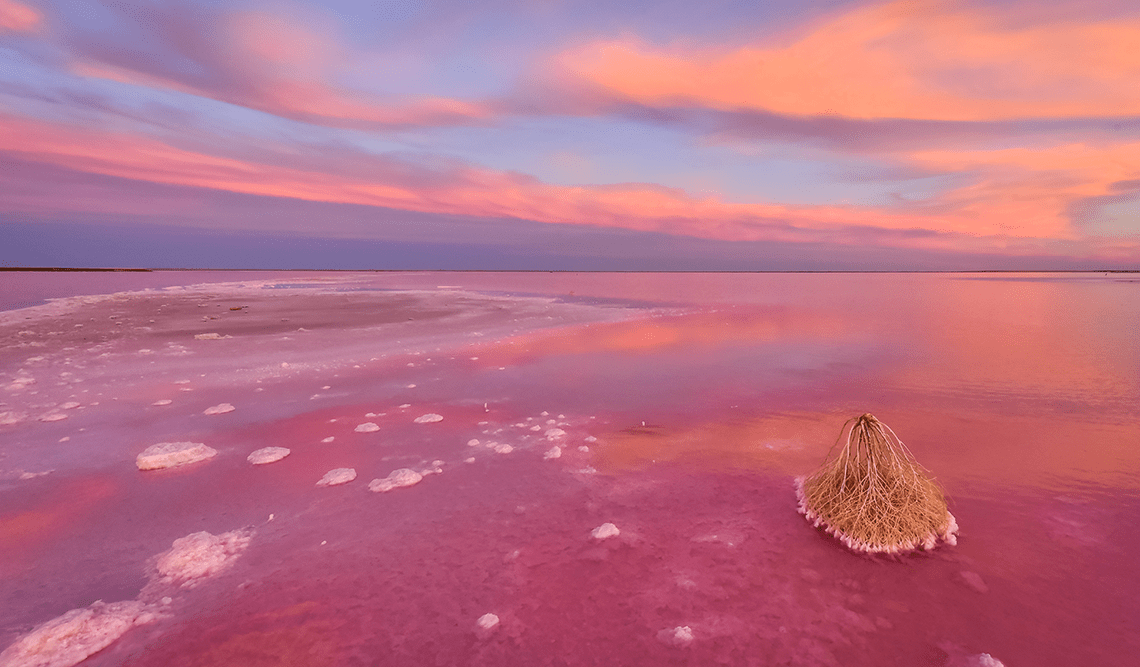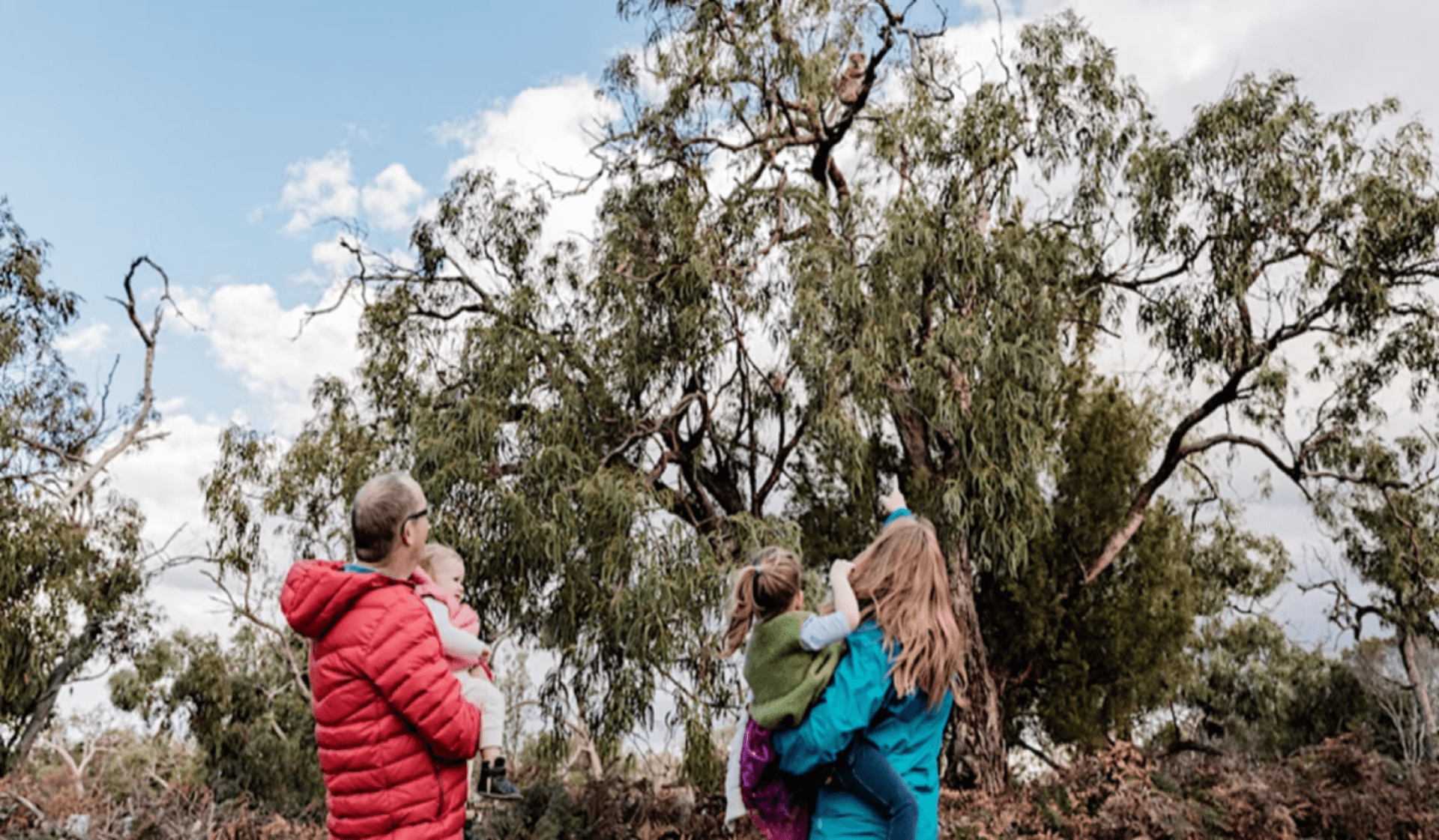Everything you need to know about Victoria's pink lakes
Thursday 21 April, 2022
You’ve probably seen photos like the pastel pink beauty below on Instagram. It may come as a surprise, but these are truly #nofilter! These are the natural changing colour of some of Victoria’s lakes. These bubblegum pink lakes are a natural wonder that many will never get to see, but there are a few right here in Victoria.

Why are the lakes pink?
We had a chat to Parks Victoria’s Chief Conservation Scientist, Dr Mark Norman to find out how these lakes get their colour.
"What you’ll find about these lakes in that they are very salty. This makes them the perfect habitat for a single-celled algae that is super adapted to live only in extremely salty conditions" explains Dr Norman.
"When the weather and water conditions are just right, the algae produces pink or red cartenoids (basically a filter, like a pair of sunglasses, to protect their chlorophyll cells and help photosynthesis) which give the lake its pink colour."
“This single-celled-algae, Dunaliela salina, belongs to a group known as ‘extremophiles’. Extremophiles are a fascinating and important group of organisms that only survive in crazy circumstances like boiling or freezing temperatures, deep underground or underwater or in super salty, acidic, radioactive environments."
"The algae is super-adapted to survive in environments where nothing else can. Then there’s the added bonus of creating a spectacular colour! The algae is the kind of ‘alien life’ that researchers hope to find on an asteroid or the moon, and we are lucky enough to have them living under a bridge in the second-largest city in Australia.”

Where can I see Pink Lakes in Victoria
"Some people have travelled all around the world to see this phenomenon and we’ve got it right on our doorstep," says Dr Norman.
Pink Lakes, Murray Sunset National Park
Murray-Sunset National Park is the largest national park in Victoria., part of an Aboriginal cultural landscape that includes traditional Country of the Latji Latji, Ngintait and Nyeri Nyeri Peoples.
The area known as Pink Lakes consists of four lakes - Crosbie, Becking, Kenyon and Hardy. Changing in colour from a glistening white to a deep pink, the lakes are a stunning sight almost all year round. They are as picturesque on bright moon-lit nights as they are in daylight.
Come for the pink lakes, stay for the wildlife! Throughout the day you can enjoy the sights and sounds of kangaroos, emus, reptiles and birds. On a warm afternoon you may see Rainbow Bee-eaters chasing flying insects or Mallee and bearded dragons scurrying to the cover of a triodia (porcupine grass) clump.
Hundreds of species of native plants grow in this region. Near the Pink Lakes, all the plants are salt-tolerant due to the high salt content of the water and soil.
Best time to see the colour:
The intensity of colour varies throughout the year and is strongest after rains wash in fresh nutrients, triggering increased growth of the algae.
How to get there:
Pink Lakes are in north-west Victoria 60km west of Ouyen, along the Mallee Highway. Turn onto an all-weather gravel road for 13km to the main camping areas. It is important to check current road conditions with park staff before visiting. Some tracks become impassable in wet weather and others are recommended only for four-wheel drive.

Westgate Park
Westgate Park is a green oasis located in under the Westgate Bridge in the heart of industrial Melbourne, part of an Aboriginal cultural landscape in the traditional Country of the Bunurong People.
The lake in the centre of the park turns a vibrant pink when conditions are right. Roughly once a year, when there is a long enough dry spell, the water from the lake evaporates enough to change from really salty to really, really, really salty, and the algae puts on its pink sunglasses to survive the extreme conditions. As soon as the rain comes and dilutes the water, or the weather gets cold and overcast, the pink colour disappears as the algae stops producing the pink cartenoids.
What’s happening in the lake when it’s not pink? Life ebbs and flows, when the pink is gone the other plants come back or get blown in by the wind, it’s a kind of natural part of the system; then when it gets super salty they all come back and the pink plants take over. It’s quite a normal cycle.
It’s a stunning sight to see this bright pink lake surrounded by the city. Located along the eastern banks of the Yarra River, the park offers spectacular views to the mouth of the Yarra and the city skyline. Enjoy a picnic lunch with friends or family or cycle along the Yarra River or the Port Melbourne foreshore.
Best time to see the colour:
Usually intermittently during the warmer months when there is a perfect mix of high salt levels, high temperatures, increased sunlight and low rainfall. The lake returns to its normal colour as the weather cools and rainfall increases.
How to get there:
Travel over the Westgate Bridge in Melbourne for a bird’s eye view of the colour. Or to get up close, limited parking is available within the park off Todd Road, or along Lorimer St, Port Melbourne. Catching the bus is a great way to visit the park.

Lake Tyrrell
Lake Tyrrell is Victoria's largest saltwater lake and forms part of an Aboriginal cultural landscape that includes traditional Country of the Wotjobaluk, Jaadwa, Jadawadjali, Wergaia and Jupagalk Nations.
Though the lake is hundreds of thousands of years old, it has become a popular visitor destination in recent years as its natural beauty caused an internet sensation.
It has attracted visitors from around the world who come for the striking scenery and the stunning sunsets and sunrises. Take in the massive star filled night skies or enjoy the sights of Mallee wildlife during the day including reptiles, kangaroos and emus.
Best time to see the colour:
During warm and wet periods when shallow water covers the lake. Lake Tyrrell is dry most of the year.
How to get there:
Lake Tyrrell is 7km north of the township of Sea Lake in Victoria’s mallee region, and 314km north west of Melbourne. Head north out of town on the Calder Highway and the lake is signposted on the right. There is information signage and viewing platform.

Loch Iel (Pink Lake) Lake Reserve
The name says it all! The lake’s unique pink hue comes from a pigment secreted by microscopic algae found in Loch Iel’s extra salty wetlands.
This reserve is a beautiful spot to unwind. The water’s edge is dotted with shady yellow gumtrees and salt paperbarks, and the reflective lake surface is a photographer’s dream.
Wander around the lake’s edge, keeping your eye out for small and distinctive salt tolerant plants that grow in this rare environment. For many years, the salt was commercially harvested from the lake and rusted-out relics of a mining operation long closed are scattered around the lake as reminders of its history.
Best time to see the colour:
The intensity of the pink varies depending on the season, temperature, cloud cover and water level. After a large downpour, fresh nutrients wash into the lake, which in turn trigger the growth of algae. Sometimes it's a bright bubble-gum pink and at other times it's a light salmon. While the iconic pink hue can’t be guaranteed, the beautiful changing shades of this lake will not disappoint.
How to get there:
Getting to Pink Lake is easy; it’s located right next to the Western Highway. Next to the highway is a rest stop and Loch Iel Reserve, from where you can easily take in views of the lake. Alternatively, visitors can also make a short trek to the edge of the lake from the rest stop.

See you there!
Autumn is a great time for exploring and making time to see the lakes for yourself.
Stand on the edge of the lakes and experience its natural beauty but don’t be tempted to jump in pink water, the super saltiness may be perfect for alien algae but can really irritate your skin.
Please respect any signs or barriers around the lakes. They are there to protect the sensitive vegetation around the lake and to keep you safe.




